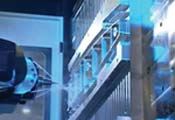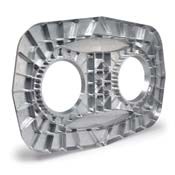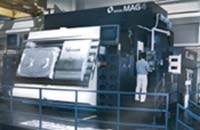Six Advantages Of Horizontal High Speed Machining
Large monolithic aircraft parts may be machined more productively one at a time instead of three at once.
Though the part is destined to soar, the method of machining is often slow and earthbound. For aircraft structural components, a common approach to machining involves laying the part beneath a gantry. That gantry may move at a relatively slow feed rate because it carries three spindles at a time. Certain large aircraft parts will continue to benefit from this approach, particularly long and narrow stringers. However, a single high speed spindle moving at high feed rates may be able to machine some monolithic parts fast enough to compete with the productivity of a gantry making three identical pieces at once. And when the high speed spindle machines in a horizontal configuration, both quality and efficiency stand to improve in a variety of ways.
In fact, where aircraft part production is concerned, “high speed” and “horizontal” go together. High speed machining is about making chips fast, and horizontal machining is about getting those chips out of the way of the cutter. A horizontal design also saves on floor space, and certain newly developed machines for large aircraft parts employ work-changing that takes advantage of a horizontal orientation.
Examples of such machines can be found in the “MAG” line of machining centers from Makino (Mason, Ohio). The five-axis horizontals in this line are designed for aircraft parts too large for typical CNC machining centers. Each MAG machine includes a 30,000-rpm, 60-kW spindle and a combination of CNC features that permit precision milling at high feeds. Models ranging in size from 4 to 16 meters of travel in X feature linear motors for this longest axis. One of these models, the MAG4, features a rotating work indexer that places tables on opposing faces like the opposite sides of a coin. While one table holds a part inside the work zone for horizontal machining, the other table locates outside the work zone for setup of the next part. To switch from one part to the next, the indexer flips to reverse these tables. (See photo, bottom of this page.)
Buying a machine like this is no idle purchase for any shop. Much of the payback has to come from the opportunity to realize a significantly more streamlined process for milling large parts. But some of the return on investment can also result simply from the switch to horizontal high speed machining, and the many process advantages this change can deliver that are specific to aerospace production.
Mark Waymouth of Makino’s aerospace group is one person frequently asked to articulate those advantages. The various benefits he cites can be divided into six categories:
1. The chips are down (and out of the way)
Aircraft part production may be the only application in which the push broom is a critical tool for precision metalworking.
Getting chips out of the way of the cut is important to both the reliability of the tool and the quality of the part. On a vertical machine such as a gantry mill, that can make sweeping between cycles an essential part of the process.
Horizontal machining eliminates the need to spend time and labor cost on this manual chip removal, because the chips fall away instead. It also reduces the various hazards that result from having chips accumulate while the cycle is underway. Less recutting of chips can result in both a better machined finish and more consistent tool life.
2. One tool may be better than three
Machining one workpiece at a time instead of machining three at once can dramatically streamline tool management. Gone is the need to change tools manually, because the toolchanger on the one-spindle machining center takes care of this. Gone too is the need to own and inventory three identical tooling sets at once.
Using one tool at a time also means it’s no longer necessary to set tools to precise dimensions so that three tools can share a common offset. At best this tool setting is time-consuming and entails labor expense, but generally it also leaves measurable error from tool to tool that limits how accurately parts can be machined when they are cut in unison. The single spindle makes it possible to machine to tighter tolerances, because machining offsets are tailored to the dimensions of one tool alone.
3. Ending blending
Reduced recutting of chips, along with the elimination of dimensional discrepancies between simultaneous tools, results in a more accurate surface with a better finish. Also enhancing the surface quality is high speed machining itself, which involves lighter cuts and therefore lower cutting forces.
The combination of these factors can let a shop avoid hand blending of machined parts. With high speed horizontal machining, the machined surface becomes the finished surface.
4. Replace three fixtures with one (maybe zero)
Replacing three spindles with one not only eliminates the need for redundant tool sets, but also eliminates the need to own and maintain redundant fixtures.
Meanwhile, high speed machining itself may reduce the part’s fixturing requirements. Cutting forces are lighter, so clamping forces can be lighter as well. It may become practical to machine the part out of a solid block. Using a “picture frame” approach that leaves tabs around the part to secure it to the rest of the block, until the machining is done and these tabs are cut away. With this approach, the only necessary workholding components are the clamps that secure the block to the table.
5. Floor space set free
Moving from a gantry to a horizontal replaces three workpieces with one . . . and the one workpiece that remains doesn’t lie on a table but instead is turned on its side. These changes alone allow the machine tool to occupy a smaller footprint.
But the transition frees up floor space in other ways as well. The one-at-a-time approach to machining leaves fewer fixtures to store. It also leaves fewer finished workpieces to store, because each cycle on the horizontal leaves just one piece to manage instead of three.
6. A thrust-to-weight ratio for the process
In a machining process as in an aircraft, weight reduction translates directly to improved performance. For the machining process, that “weight” takes the form of lead time requirements that impede flexibility and inventory requirements that tie up available capital. A high speed horizontal approach to machining large parts can help the process shed these pounds.
First, the cycle time is shorter. That means the shop can deliver a finished part without as much advance notice from the customer.
Meanwhile, the optimum batch size for the machine shrinks from three pieces to one. The shop can run more efficiently in those cases when the ordersize is small. If the customer orders just one piece, for example, the shop is no longer left with the hard choice of either running a three-spindle machine at less than its full capacity, or else keeping the additional pieces in inventory until the customer places another such order again.
Related Content
Threading On A Lathe
The right choices in tooling and technique can optimize the thread turning process.
Read MoreChoosing Your Carbide Grade: A Guide
Without an international standard for designating carbide grades or application ranges, users must rely on relative judgments and background knowledge for success.
Read MoreA New Milling 101: Milling Forces and Formulas
The forces involved in the milling process can be quantified, thus allowing mathematical tools to predict and control these forces. Formulas for calculating these forces accurately make it possible to optimize the quality of milling operations.
Read MoreWhen Organic Growth in Your Machine Shop Isn’t Enough
Princeton Tool wanted to expand its portfolio, increase its West Coast presence, and become a stronger overall supplier. To accomplish all three goals at once, acquiring another machine shop became its best option.
Read MoreRead Next
The Cut Scene: The Finer Details of Large-Format Machining
Small details and features can have an outsized impact on large parts, such as Barbco’s collapsible utility drill head.
Read More3 Mistakes That Cause CNC Programs to Fail
Despite enhancements to manufacturing technology, there are still issues today that can cause programs to fail. These failures can cause lost time, scrapped parts, damaged machines and even injured operators.
Read More
.jpg;width=70;height=70;mode=crop)











.png;maxWidth=300;quality=90)





.png;maxWidth=300;quality=90)














